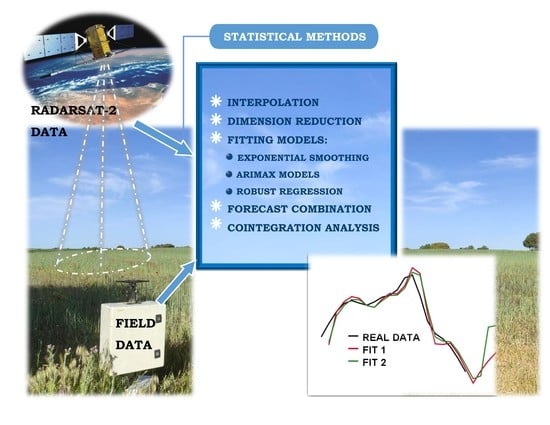Time Series of Quad-Pol C-Band Synthetic Aperture Radar for the Forecasting of Crop Biophysical Variables of Barley Fields Using Statistical Techniques
Abstract
:1. Introduction
2. Materials
2.1. Study Area and Field Data
2.2. Satellite Data and Pre-Processing
3. Methods
3.1. Interpolation
3.2. Dimension Reduction
3.3. Fitting Models
3.3.1. Exponential Smoothing
3.3.2. ARIMAX Models
3.3.3. Robust Regression
3.4. Forecast Combination Techniques
- Weighted least squares (WLS) requires knowledge of the true values of the forecasted variable for some of the forecast period. It compares real values with predictions using the regression coefficients as weights. This method does not require that the underlying individual forecasts are unbiased, and the resulting average can lie outside the range of the underlying forecasts.
- Weighted mean squared error (MSE) consists of making a weighted average giving greater weight to the predictions of the models with less mean squared error. Stock and Watson [68] propose MSE weighting, which compares individual forecasts with real values over a forecast period.
3.5. Cointegration Analysis
- The existence of cointegration between time series requires that each one is non-stationary, but the linear combination is stationary [70]. The augmented Dicky–Fuller test contrasts the null hypothesis for the existence of a unit root, equivalent to non-stationarity. To assess that both series are non-stationary, the augmented Dicky–Fuller test is used [56,71].
- Granger’s causality test [72] checks whether the results of one variable serve to predict another variable analyzing the causal relationships between time series. Once this test is carried out, the cointegration equation is constructed, permitting one variable to be predicted using the results from another.
- Johansen’s cointegration test [73,74] is another method to test the cointegration of several series. There are two types of Johansen tests, either with trace or with eigenvalue (maximum eigenvalue test). The inferences obtained with both alternatives may derive quite similar results; in this case, the results have been obtained with the trace.
4. Results
4.1. Dimension Reduction
4.2. Analysis of Fitting Models over the Barley Crop on Field F11
4.2.1. Double Smoothing Adjustment
4.2.2. ARIMAX Adjustment and Robust Regression
4.2.3. Combination of Forecasts
4.3. Prediction of Biophysical Variables of Barley on M9
5. Discussion
6. Conclusions
Author Contributions
Funding
Conflicts of Interest
References
- Yu, R.; Evans, A.J.; Malleson, N. Quantifying grazing patterns using a new growth function based on MODIS Leaf Area Index. Remote Sens. Environ. 2018, 209, 181–194. [Google Scholar] [CrossRef] [Green Version]
- Champagne, C.; White, J.; Berg, A.; Belair, S.; Carrera, M. Impact of soil moisture data characteristics on the sensitivity to crop yields under drought and excess moisture conditions. Remote Sens. 2019, 11, 372. [Google Scholar] [CrossRef] [Green Version]
- Habyarimana, E.; Piccard, I.; Catellani, M.; De Franceschi, P.; Dall’Agata, M. Towards predictive modeling of sorghum biomass yields using fraction of absorbed photosynthetically active radiation derived from sentinel-2 satellite imagery and supervised machine learning techniques. Agronomy 2019, 9, 203. [Google Scholar] [CrossRef] [Green Version]
- White, J.; Berg, A.A.; Champagne, C.; Zhang, Y.; Chipanshi, A.; Daneshfar, B. Improving crop yield forecasts with satellite-based soil moisture estimates: An example for township level canola yield forecasts over the Canadian Prairies. Int. J. Appl. Earth Obs. Geoinf. 2020, 89, 102092. [Google Scholar] [CrossRef]
- Brocca, L.; Ciabatta, L.; Massari, C.; Camici, S.; Tarpanelli, A. Soil moisture for hydrological applications: Open questions and new opportunities. Water 2017, 9, 140. [Google Scholar] [CrossRef]
- Martínez-Fernández, J.; González-Zamora, A.; Sánchez, N.; Gumuzzio, A.; Herrero-Jiménez, C.M. Satellite soil moisture for agricultural drought monitoring: Assessment of the SMOS derived Soil Water Deficit Index. Remote Sens. Environ. 2016, 177, 277–286. [Google Scholar] [CrossRef]
- Martínez-Fernández, J.; Sánchez, N.; González-Zamora, Á. Agricultural drought monitoring using satellite soil moisture and other remote sensing data over the Iberian Peninsula. In Remote Sensing of Hydrometeorological Hazards; Petropoulos, G.P., Islam, T., Eds.; CRC Press, Taylor & Francis Group: Boca Raton, FL, USA, 2017; p. 549. ISBN 9781498777599. [Google Scholar]
- Sánchez, N.; González-Zamora, Á.; Martínez-Fernández, J.; Piles, M.; Pablos, M. Integrated remote sensing approach to global agricultural drought monitoring. Agric. For. Meteorol. 2018, 259, 141–153. [Google Scholar] [CrossRef]
- Sánchez, N.; González-Zamora, Á.; Piles, M.; Martínez-Fernández, J. A new Soil Moisture Agricultural Drought Index (SMADI) integrating MODIS and SMOS products: A case of study over the Iberian Peninsula. Remote Sens. 2016, 8, 287. [Google Scholar] [CrossRef] [Green Version]
- Mousivand, A.; Menenti, M.; Gorte, B.; Verhoef, W. Multi-temporal, multi-sensor retrieval of terrestrial vegetation properties from spectral-directional radiometric data. Remote Sens. Environ. 2015, 158, 311–330. [Google Scholar] [CrossRef]
- Campos-Taberner, M.; Moreno-Martínez, Á.; García-Haro, F.J.; Camps-Valls, G.; Robinson, N.P.; Kattge, J.; Running, S.W. Global estimation of biophysical variables from Google Earth Engine platform. Remote Sens. 2018, 10, 1167. [Google Scholar] [CrossRef] [Green Version]
- Djamai, N.; Fernandes, R.; Weiss, M.; McNairn, H.; Goïta, K. Validation of the Sentinel Simplified Level 2 Product Prototype Processor (SL2P) for mapping cropland biophysical variables using Sentinel-2/MSI and Landsat-8/OLI data. Remote Sens. Environ. 2019, 225, 416–430. [Google Scholar] [CrossRef]
- Upreti, D.; Huang, W.; Kong, W.; Pascucci, S.; Pignatti, S.; Zhou, X.; Ye, H.; Casa, R. A comparison of hybrid machine learning algorithms for the retrieval of wheat biophysical variables from Sentinel-2. Remote Sens. 2019, 11, 481. [Google Scholar] [CrossRef] [Green Version]
- Xie, Q.; Dash, J.; Huete, A.; Jiang, A.; Yin, G.; Ding, Y.; Peng, D.; Hall, C.C.; Brown, L.; Shi, Y.; et al. Retrieval of crop biophysical parameters from Sentinel-2 remote sensing imagery. Int. J. Appl. Earth Obs. Geoinf. 2019, 80, 187–195. [Google Scholar] [CrossRef]
- Ulaby, F.T. Radar response to vegetation. IEEE Trans. Antennas Propag. 1975, 23, 36–45. [Google Scholar] [CrossRef]
- Ulaby, F.T.; Bush, T.F.; Batlivala, P.P. Radar response to vegetation II: 8–18 GHz band. IEEE Trans. Antennas Propag. 1975, 23, 608–618. [Google Scholar] [CrossRef]
- Liu, C.A.; Chen, Z.X.; Shao, Y.; Chen, J.S.; Hasi, T.; Pan, H. Research advances of SAR remote sensing for agriculture applications: A review. J. Integr. Agric. 2019, 18, 506–525. [Google Scholar] [CrossRef] [Green Version]
- Moran, M.S.; Alonso, L.; Moreno, J.F.; Cendrero Mateo, M.P.; de la Cruz, D.F.; Montoro, A. A RADARSAT-2 quad-polarized time series for monitoring crop and soil conditions in Barrax, Spain. IEEE Trans. Geosci. Remote Sens. 2012, 50, 1057–1070. [Google Scholar] [CrossRef]
- Vreugdenhil, M.; Wagner, W.; Bauer-Marschallinger, B.; Pfeil, I.; Teubner, I.; Rüdiger, C.; Strauss, P. Sensitivity of Sentinel-1 backscatter to vegetation dynamics: An Austrian case study. Remote Sens. 2018, 10, 1396. [Google Scholar] [CrossRef] [Green Version]
- Attema, E.P.W.; Ulaby, F.T. Vegetation modeled as a water cloud. Radio Sci. 1978, 13, 357–364. [Google Scholar] [CrossRef]
- Hosseini, M.; McNairn, H. Using multi-polarization C- and L-band synthetic aperture radar to estimate biomass and soil moisture of wheat fields. Int. J. Appl. Earth Obs. Geoinf. 2017, 58, 50–64. [Google Scholar] [CrossRef]
- Ulaby, F.T.; Batlivala, P.P.; Dobson, M.C. Microwave backscatter dependence on surface roughness, soil moisture, and soil texture: Part I–bare soil. IEEE Trans. Geosci. Electron. 1978, 16, 286–295. [Google Scholar] [CrossRef]
- Guo, X.; Li, K.; Shao, Y.; Wang, Z.; Li, H.; Yang, Z.; Liu, L.; Wang, S. Inversion of rice biophysical parameters using simulated compact polarimetric sar c-band data. Sensors 2018, 18, 2271. [Google Scholar] [CrossRef] [Green Version]
- Mandal, D.; Kumar, V.; Lopez-Sanchez, J.M.; Bhattacharya, A.; McNairn, H.; Rao, Y.S. Crop biophysical parameter retrieval from Sentinel-1 SAR data with a multi-target inversion of Water Cloud Model. Int. J. Remote Sens. 2020, 41, 5503–5524. [Google Scholar] [CrossRef]
- Chen, K.S.; Yen, S.K.; Huang, W.P. A simple model for retrieving bare soil moisture from radar-scattering coefficients. Remote Sens. Environ. 1995, 54, 121–126. [Google Scholar] [CrossRef]
- Shi, J.; Wang, J.; Hsu, A.Y.; O’Neill, P.E.; Engman, E.T. Estimation of bare surface soil moisture and surface roughness parameter using L-band SAR image data. IEEE Trans. Geosci. Remote Sens. 1997, 35, 1254–1266. [Google Scholar] [CrossRef]
- Oh, Y.; Sarabandi, K.; Ulaby, F.T. Semi-empirical model of the ensemble-averaged differential Mueller matrix for microwave backscattering from bare soil surfaces. IEEE Trans. Geosci. Remote Sens. 2002, 40, 1348–1355. [Google Scholar] [CrossRef] [Green Version]
- Oh, Y. Quantitative retrieval of soil moisture content and surface roughness from multipolarized radar observations of bare soil surfaces. IEEE Trans. Geosci. Remote Sens. 2004, 42, 596–601. [Google Scholar] [CrossRef]
- Álvarez-Mozos, J.; González-Audícana, M.; Casalí, J. Evaluation of empirical and semi-empirical backscattering models for surface soil moisture estimation. Can. J. Remote Sens. 2007, 33, 176–188. [Google Scholar] [CrossRef]
- Wang, H.; Méric, S.; Allain, S.; Pottier, E. Adaptation of Oh Model for soil parameters retrieval using multi-angular RADARSAT-2 datasets. J. Surv. Mapp. Eng. 2014, 2, 65–74. [Google Scholar]
- Fung, A.K.; Chen, K.S. Dependence of the surface backscattering coefficients on roughness, frequency and polarization states. Int. J. Remote Sens. 1992, 13, 1663–1680. [Google Scholar] [CrossRef]
- Ulaby, F.T.; Moore, R.K.; Fung, A.K. Microwave Remote Sensing: Active and Passive/Volume II, Radar Remote Sensing and Surface Scattering and Emission Theory; Addison-Wesley: Reading, MA, USA, 1982. [Google Scholar]
- Fung, A.K.; Chen, K.S. An update on the IEM surface backscattering model. IEEE Geosci. Remote Sens. Lett. 2004, 1, 75–77. [Google Scholar] [CrossRef]
- Der Wu, T.; Chen, K.S.; Shi, J.; Fung, A.K. A transition model for the reflection coefficient in surface scattering. IEEE Trans. Geosci. Remote Sens. 2001, 39, 2040–2050. [Google Scholar] [CrossRef]
- Lievens, H.; Verhoest, N.E.C. On the retrieval of soil moisture in wheat fields from L-band SAR based on water cloud modeling, the IEM, and effective roughness parameters. IEEE Geosci. Remote Sens. Lett. 2011, 8, 740–744. [Google Scholar] [CrossRef]
- Bai, X.; He, B.; Xing, M.; Li, X. Method for soil moisture retrieval in arid prairie using TerraSAR-X data. J. Appl. Remote Sens. 2015, 9, 096062. [Google Scholar] [CrossRef]
- Bai, X.; He, B.; Li, X.; Zeng, J.; Wang, X.; Wang, Z.; Zeng, Y.; Su, Z. First assessment of Sentinel-1A data for surface soil moisture estimations using a coupled water cloud model and advanced integral equation model over the Tibetan Plateau. Remote Sens. 2017, 9, 714. [Google Scholar] [CrossRef] [Green Version]
- Mestre-Quereda, A.; Lopez-Sanchez, J.M.; Vicente-Guijalba, F.; Jacob, A.W.; Engdahl, M.E. Time Series of Sentinel-1 Interferometric Coherence and Backscatter for Crop-Type Mapping. IEEE J. Sel. Top. Appl. Earth Obs. Remote Sens. 2020, 13, 4070–4084. [Google Scholar] [CrossRef]
- Nasirzadehdizaji, R.; Cakir, Z.; Balik Sanli, F.; Abdikan, S.; Pepe, A.; Calò, F. Sentinel-1 interferometric coherence and backscattering analysis for crop monitoring. Comput. Electron. Agric. 2021, 185, 106118. [Google Scholar] [CrossRef]
- Shang, J.; Liu, J.; Poncos, V.; Geng, X.; Qian, B.; Chen, Q.; Dong, T.; Macdonald, D.; Martin, T.; Kovacs, J.; et al. Detection of crop seeding and harvest through analysis of time-series Sentinel-1 interferometric SAR data. Remote Sens. 2020, 12, 1551. [Google Scholar] [CrossRef]
- Jiang, B.; Liang, S.; Wang, J.; Xiao, Z. Modeling MODIS LAI time series using three statistical methods. Remote Sens. Environ. 2010, 114, 1432–1444. [Google Scholar] [CrossRef]
- Han, P.; Wang, P.X.; Zhang, S.Y.; Zhu, D.H. Drought forecasting based on the remote sensing data using ARIMA models. Math. Comput. Model. 2010, 51, 1398–1403. [Google Scholar] [CrossRef]
- Fernández-Manso, A.; Quintano, C.; Fernández-Manso, O. Forecast of NDVI in coniferous areas using temporal ARIMA analysis and climatic data at a regional scale. Int. J. Remote Sens. 2011, 32, 1595–1617. [Google Scholar] [CrossRef]
- González-Zamora, A.; Sánchez, N.; Martínez-Fernández, J. Validation of Aquarius soil moisture products over the Northwest of Spain: A comparison with SMOS. IEEE J. Sel. Top. Appl. Earth Obs. Remote Sens. 2016, 9, 2763–2769. [Google Scholar] [CrossRef]
- Martínez-Fernández, J.; González-Zamora, A.; Almendra-Martín, L. Soil moisture memory and soil properties: An analysis with the stored precipitation fraction. J. Hydrol. 2021, 593, 125622. [Google Scholar] [CrossRef]
- Sánchez, N.; Martínez-Fernández, J.; Scaini, A.; Pérez-Gutiérrez, C. Validation of the SMOS L2 Soil Moisture Data in the REMEDHUS Network (Spain). IEEE Trans. Geosci. Remote Sens. 2012, 50, 1602–1611. [Google Scholar] [CrossRef]
- Valcarce-Diñeiro, R.; Lopez-Sanchez, J.M.; Sánchez, N.; Arias-Pérez, B.; Martínez-Fernández, J. Influence of incidence angle in the correlation of C-band polarimetric parameters with biophysical variables of rain-fed crops. Can. J. Remote Sens. 2018, 44, 643–659. [Google Scholar] [CrossRef]
- Sánchez, N.; Martínez-Fernández, J.; González-Piqueras, J.; González-Dugo, M.P.; Baroncini-Turrichia, G.; Torres, E.; Calera, A.; Pérez-Gutiérrez, C. Water balance at plot scale for soil moisture estimation using vegetation parameters. Agric. For. Meteorol. 2012, 166–167, 1–9. [Google Scholar] [CrossRef]
- Cloude, S.R.; Pottier, E. A review of target decomposition theorems in radar polarimetry. IEEE Trans. Geosci. Remote Sens. 1996, 34, 498–518. [Google Scholar] [CrossRef]
- Quintero Salazar, E.; Urueña, W.; Gallego Becerra, H. Interfaz gráfica para la interpolación de datos a través de Splines Cúbicos. Sci. Tech. 2010, 1, 195–200. [Google Scholar] [CrossRef]
- Hotelling, H. Analysis of a complex of statistical variables into principal components. J. Educ. Psychol. 1933, 24, 417–441. [Google Scholar] [CrossRef]
- Jackson, J.E. A User’s Guide to Principal Components; John Wiley & Sons, Inc.: New York, NY, USA, 1991. [Google Scholar]
- Jolliffe, I. Principal Component Analysis, 2nd ed.; Springer: New York, NY, USA, 2002; ISBN 978-0-387-95442-4. [Google Scholar]
- Gardner, E.S. Exponential smoothing: The state of the art. J. Forecast. 1985, 4, 1–28. [Google Scholar] [CrossRef]
- Box, G.E.P.; Jenkins, G.M. Time Series Analysis: Forecasting and Control; Holden-Day: San Francisco, CA, USA, 1970; ISBN 0816210942. [Google Scholar]
- Hamilton, J.D. Time Series Analysis; Princeton University Press: Princeton, NJ, USA, 1994; ISBN 0691042896. [Google Scholar]
- Brockwell, P.J.; Davis, R.A. Time Series: Theory and Methods, 2nd ed.; Springer: New York, NY, USA, 1991; ISBN 978-0-387-97429-3. [Google Scholar]
- Ljung, G.M.; Box, G.E.P. On a measure of lack of fit in time series models. Biometrika 1978, 65, 297–303. [Google Scholar] [CrossRef]
- Huber, P.J. Robust regression: Asymptotics, conjectures and Monte Carlo. Ann. Stat. 1973, 1, 799–821. [Google Scholar] [CrossRef]
- Rousseeuw, P.; Yohai, V. Robust regression by means of S-estimators. In Robust and Nonlinear Time Series Analysis; Springer: New York, NY, USA, 1984; pp. 256–272. [Google Scholar]
- Yohai, V.J. High breakdown-point and high efficiency robust estimates for regression. Ann. Stat. 1987, 15, 642–656. [Google Scholar] [CrossRef]
- Fair, R.C. Evaluating the predictive accuracy of models. In Handbook of Econometrics; Griliches, Z., Intriligator, M.D., Eds.; Elsevier: Amsterdam, The Netherlands, 1986; pp. 1979–1995. [Google Scholar]
- Bates, J.; Granger, C.W. The combination of forecasts. Oper. Res. Q. 1969, 20, 451–468. [Google Scholar] [CrossRef]
- Clemen, R.T. Combining forecasts: A review and annotated bibliography. Int. J. Forecast. 1989, 5, 559–583. [Google Scholar] [CrossRef]
- Makridakis, S.; Hibon, M. The M3-competition: Results, conclusions and implications. Int. J. Forecast. 2000, 16, 451–476. [Google Scholar] [CrossRef]
- Timmermann, A. Forecast combinations. In Handbook of Economic Forecasting; Granger, C.W.J., Elliot, G., Timmermann, A., Eds.; Elsevier: Amsterdam, The Netherlands, 2006; pp. 135–196. [Google Scholar]
- Granger, C.W.J.; Elliot, G.; Timmermann, A. Handbook of Economic Forecasting; Elsevier: Amsterdam, The Netherlands, 2006. [Google Scholar]
- Stock, J.H.; Watson, M.W. Vector autoregressions. J. Econ. Perspect. 2001, 15, 101–105. [Google Scholar] [CrossRef] [Green Version]
- Engle, R.F.; Granger, C.W.J. Co-integration and error correction: Representation, estimation, and testing. Econometrica 1987, 55, 251–276. [Google Scholar] [CrossRef]
- Perman, R. Cointegration: An Introduction to the literature. J. Econ. Stud. 1991, 18. [Google Scholar] [CrossRef]
- Dickey, D.A.; Fuller, W.A. Distribution of the estimators for autoregressive time series with a unit root. J. Am. Stat. Assoc. 1979, 74, 427–431. [Google Scholar] [CrossRef]
- Granger, C.W.J. Investigating causal relations by econometric models and cross-spectral methods. Econometrica 1969, 37, 424–438. [Google Scholar] [CrossRef]
- Johansen, S. Estimation and hypothesis testing of cointegration vectors in gaussian vector autoregressive models. Econometrica 1991, 59, 1551–1580. [Google Scholar] [CrossRef]
- Johansen, S. Likelihood-Based Inference in Cointegrated Vector Autoregressive Models; Oxford University Press: Oxford, UK, 1995; ISBN 9780198774501. [Google Scholar]
- Allen, R.G.; Pereira, L.S.; Raes, D.; Smith, M. Crop Evapotranspiration—Guidelines for Computing Crop Water Requirements—FAO Irrigation and Drainage Paper 56; FAO: Rome, Italy, 1998.
- Khabbazan, S.; Vermunt, P.; Steele-Dunne, S.; Arntz, L.R.; Marinetti, C.; van der Valk, D.; Iannini, L.; Molijn, R.; Westerdijk, K.; van der Sande, C. Crop monitoring using Sentinel-1 data: A case study from The Netherlands. Remote Sens. 2019, 11, 1887. [Google Scholar] [CrossRef] [Green Version]
- Raes, D.; Steduto, P.; Hsiao, T.C.; Fereres, E. Aquacrop-The FAO crop model to simulate yield response to water: II. main algorithms and software description. Agron. J. 2009, 101, 438–447. [Google Scholar] [CrossRef] [Green Version]
- Bauböck, R. Simulating the yields of bioenergy and food crops with the crop modeling software BioSTAR: The carbon-based growth engine and the BioSTAR ET0 method. Environ. Sci. Eur. 2014, 26, 26. [Google Scholar] [CrossRef] [Green Version]
- Carlson, T.N.; Gillies, R.R.; Perry, E.M. A method to make use of thermal infrared temperature and NDVI measurements to infer surface soil water content and fractional vegetation cover. Remote Sens. Rev. 1994, 9, 161–173. [Google Scholar] [CrossRef]
- Moran, M.S.; Maas, S.J.; Vanderbilt, V.C.; Barnes, E.M.; Miller, S.N.; Clarke, T.R. Application of image based remote sensing to irrigated agriculture. In Remote Sensing for Natural Resources Management and Environmental Monitoring: Manual of Remote Sensing; Ustin, S.L., Ed.; John Wiley & Sons, Inc.: London, UK, 2004; pp. 617–676. [Google Scholar]
- Sandholt, I.; Rasmussen, K.; Andersen, J. A simple interpretation of the surface temperature/vegetation index space for assessment of surface moisture status. Remote Sens. Environ. 2002, 79, 213–224. [Google Scholar] [CrossRef]
- Soares, J.V.; Rennó, C.D.; Formaggio, A.R.; Yanasse, C.D.C.F.; Frery, A.C. An investigation of the selection of texture features for crop discrimination using SAR imagery. Remote Sens. Environ. 1997, 59, 234–247. [Google Scholar] [CrossRef]
- Erten, E.; Rossi, C.; Yüzügüllü, O. Polarization Impact in TanDEM-X Data over Vertical-Oriented Vegetation: The Paddy-Rice Case Study. IEEE Geosci. Remote Sens. Lett. 2015, 12, 1501–1505. [Google Scholar] [CrossRef] [Green Version]
- Inoue, Y.; Kurosu, T.; Maeno, H.; Uratsuka, S.; Kozu, T.; Dabrowska-Zielinska, K.; Qi, J. Season-long daily measurements of multifrequency (Ka, Ku, X, C, and L) and full-polarization backscatter signatures over paddy rice field and their relationship with biological variables. Remote Sens. Environ. 2002, 81, 194–204. [Google Scholar] [CrossRef]
- Yuzugullu, O.; Marelli, S.; Erten, E.; Sudret, B.; Hajnsek, I. Determining rice growth stage with X-Band SAR: A metamodel based inversion. Remote Sens. 2017, 9, 460. [Google Scholar] [CrossRef] [Green Version]
- Maity, S.; Patnaik, C.; Chakraborty, M.; Panigrahy, S. Analysis of temporal backscattering of cotton crops using a semiempirical model. IEEE Trans. Geosci. Remote Sens. 2004, 42, 577–587. [Google Scholar] [CrossRef]
- Lim, K.-S.; Koo, V.C.; Ewe, H.-T. Multi-Angular Scatterometer Measurements for Various Stages of Rice Growth. Prog. Electromagn. Res. 2008, 83, 385–396. [Google Scholar] [CrossRef] [Green Version]
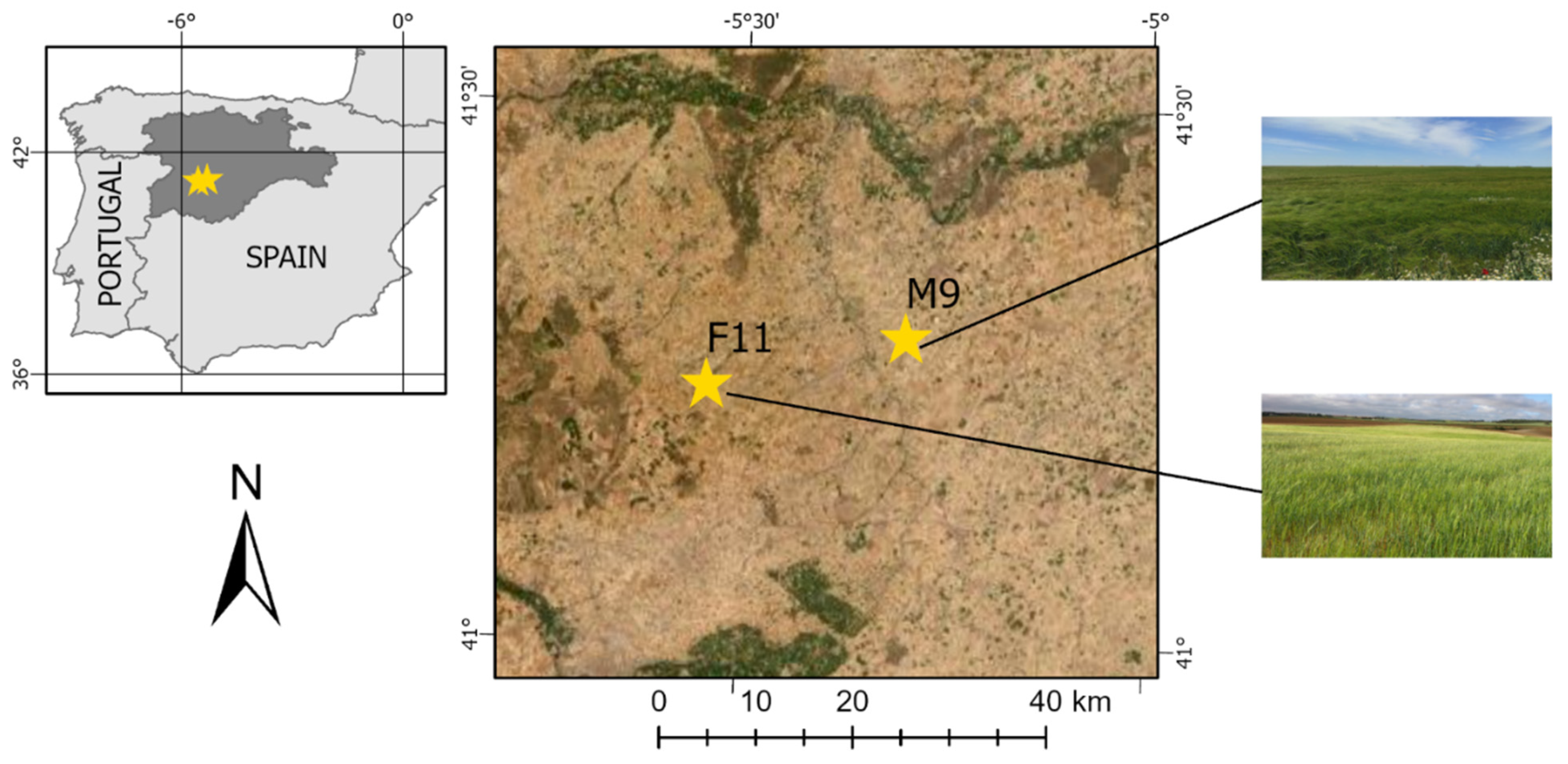
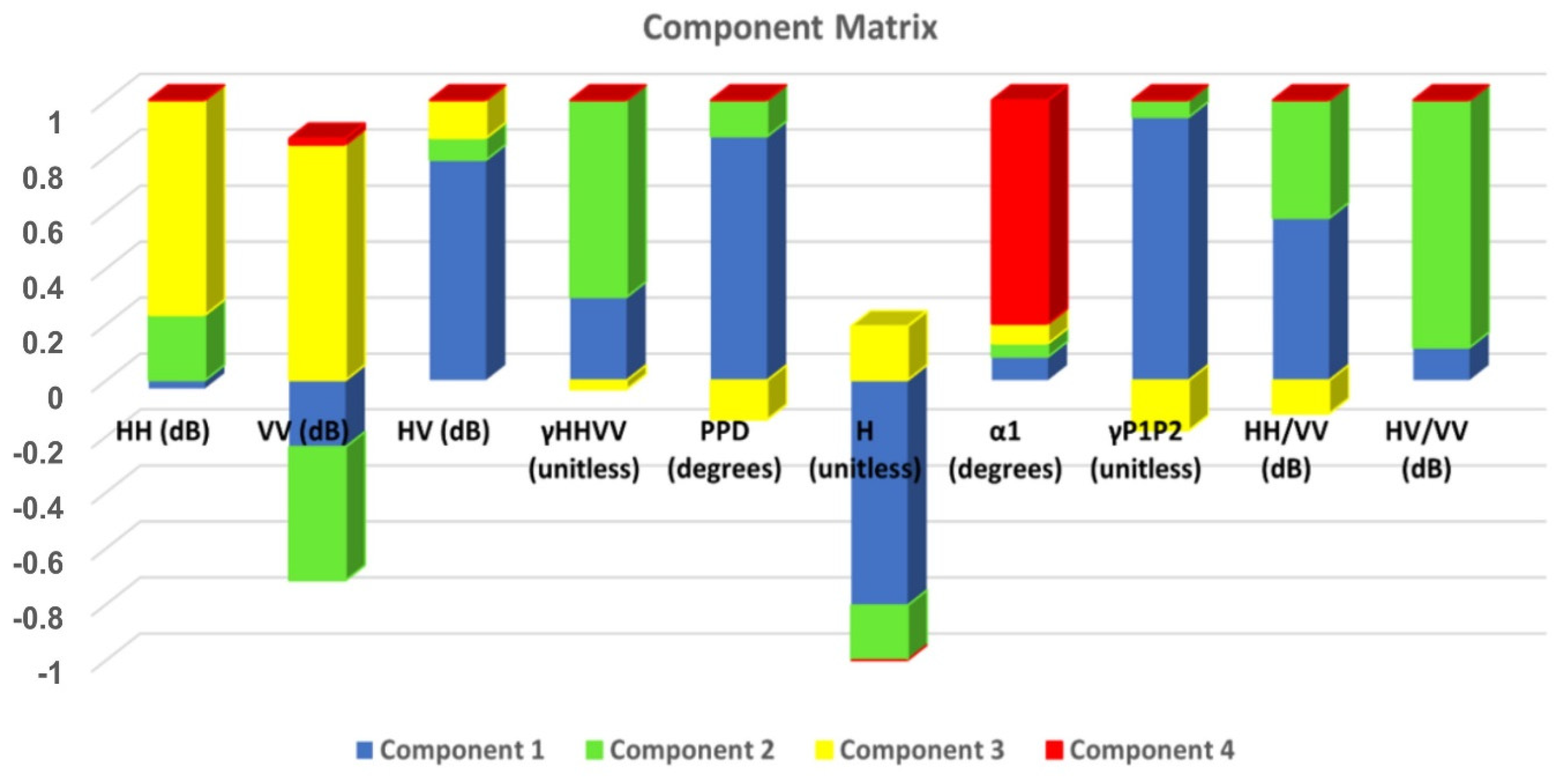
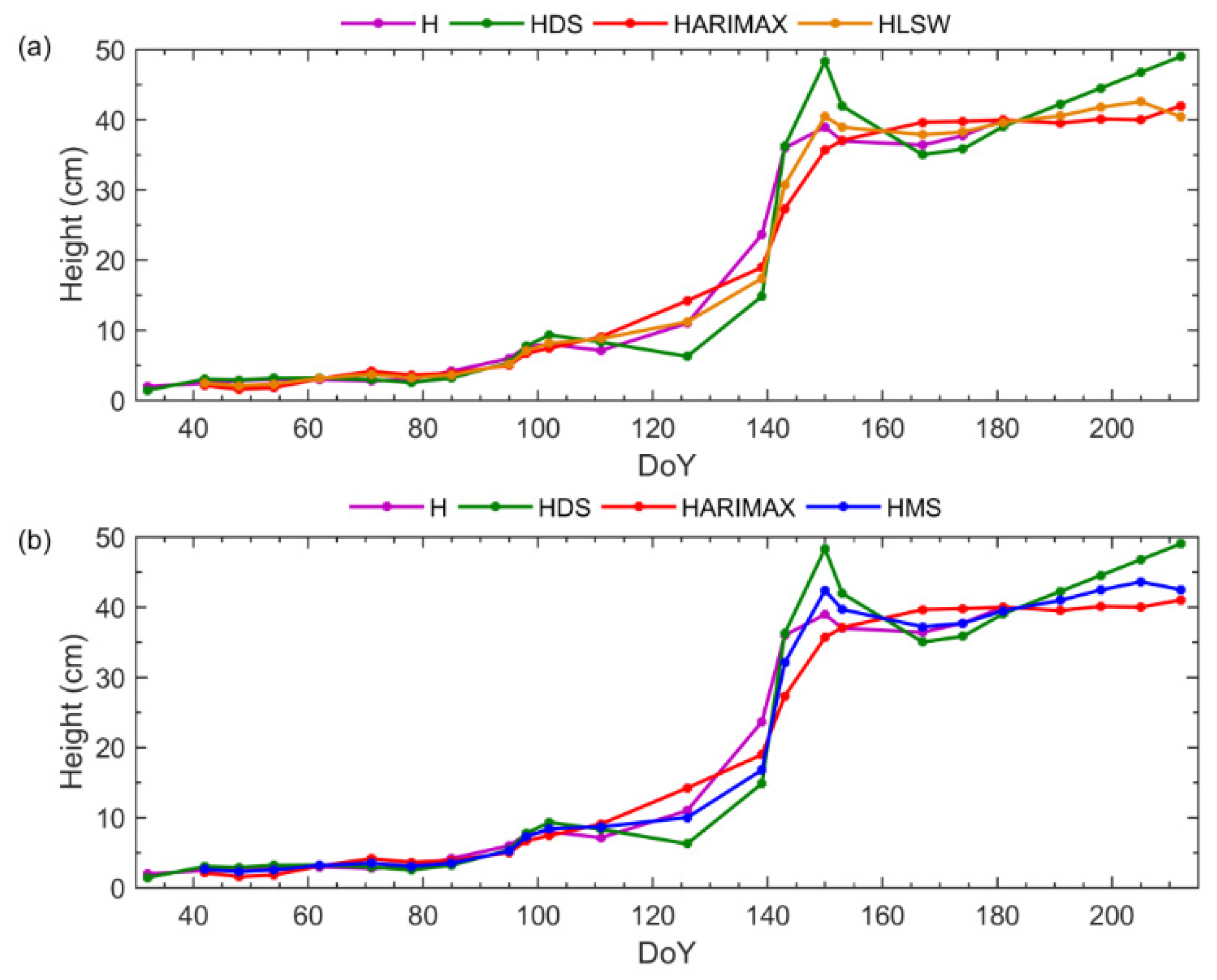
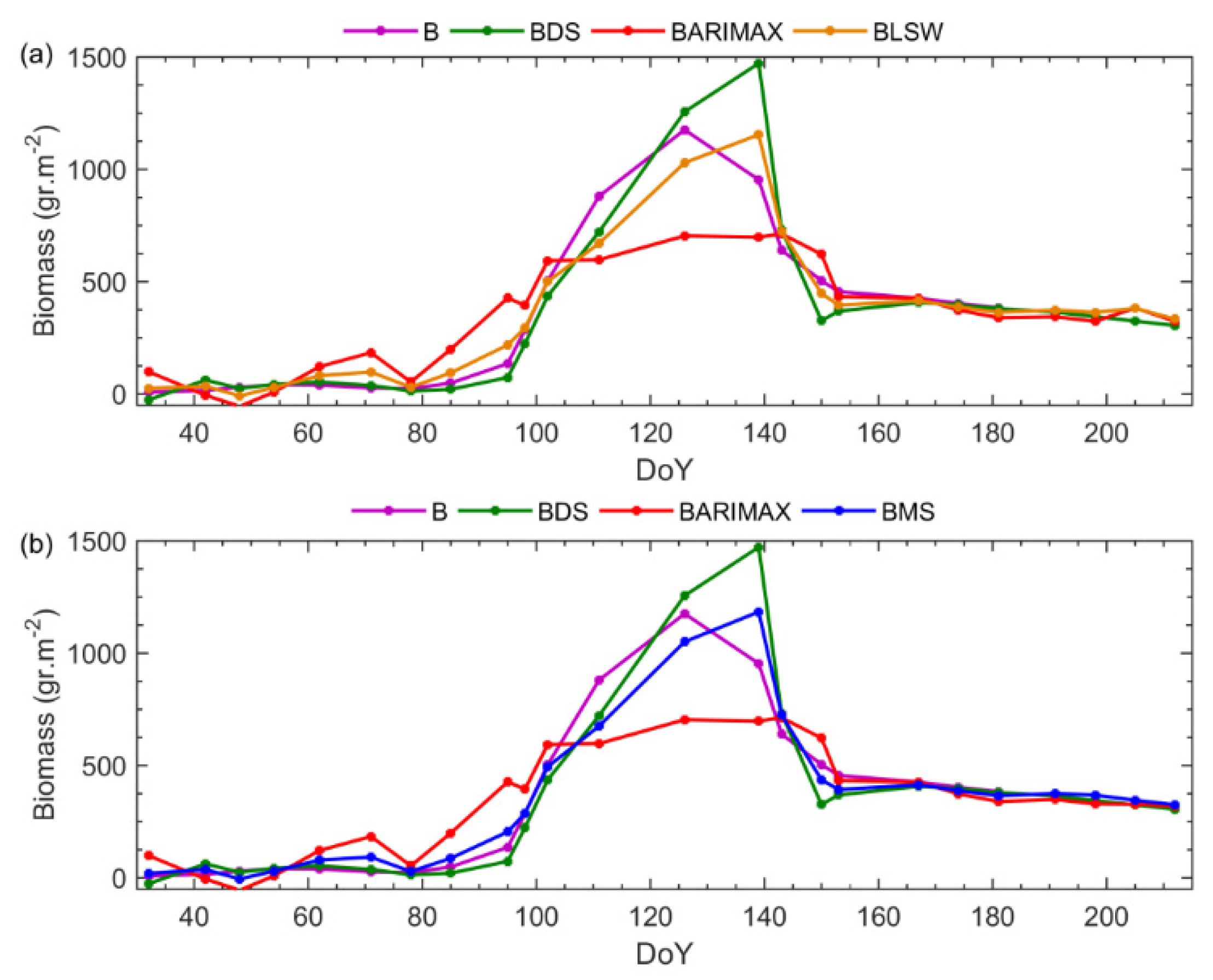
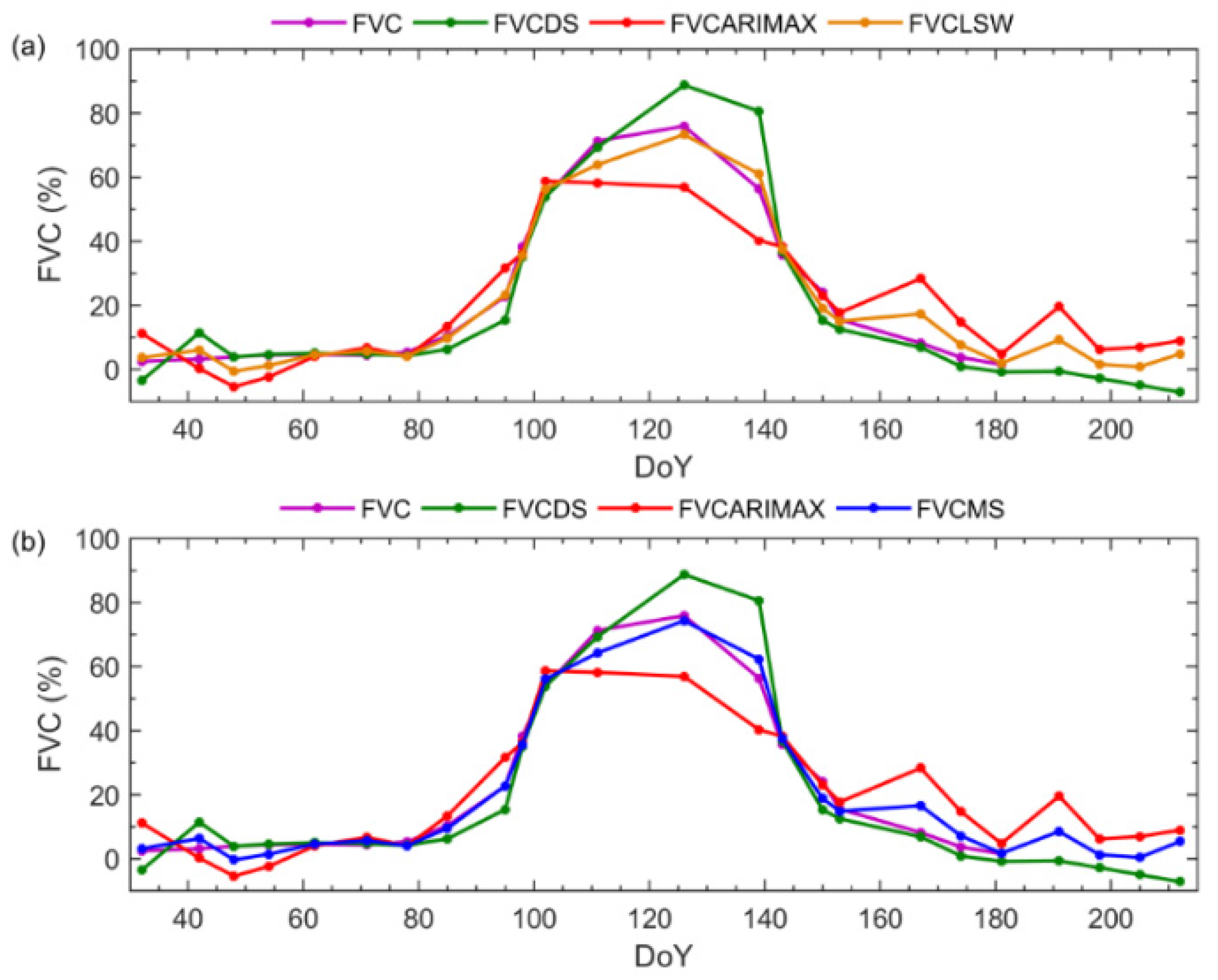

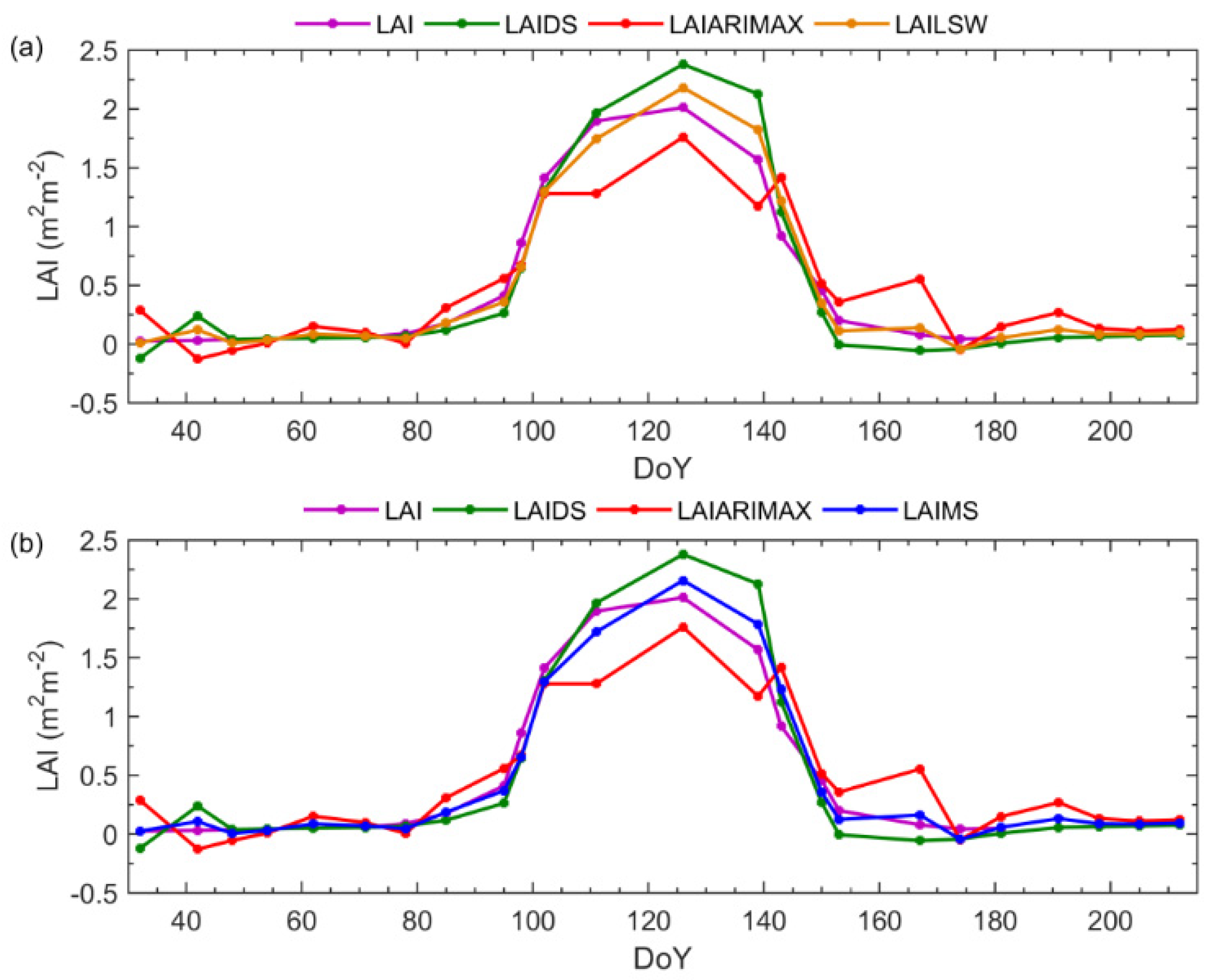

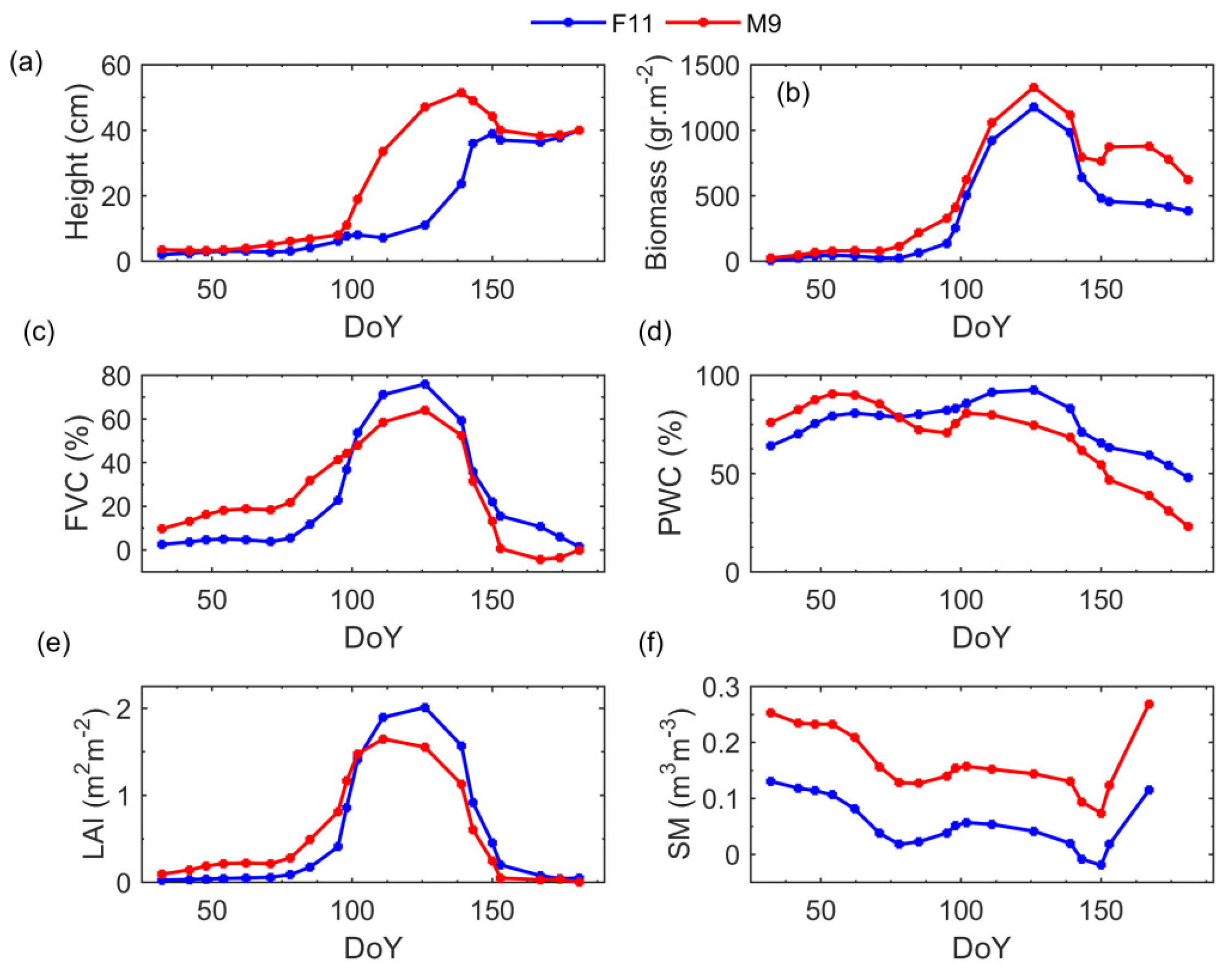
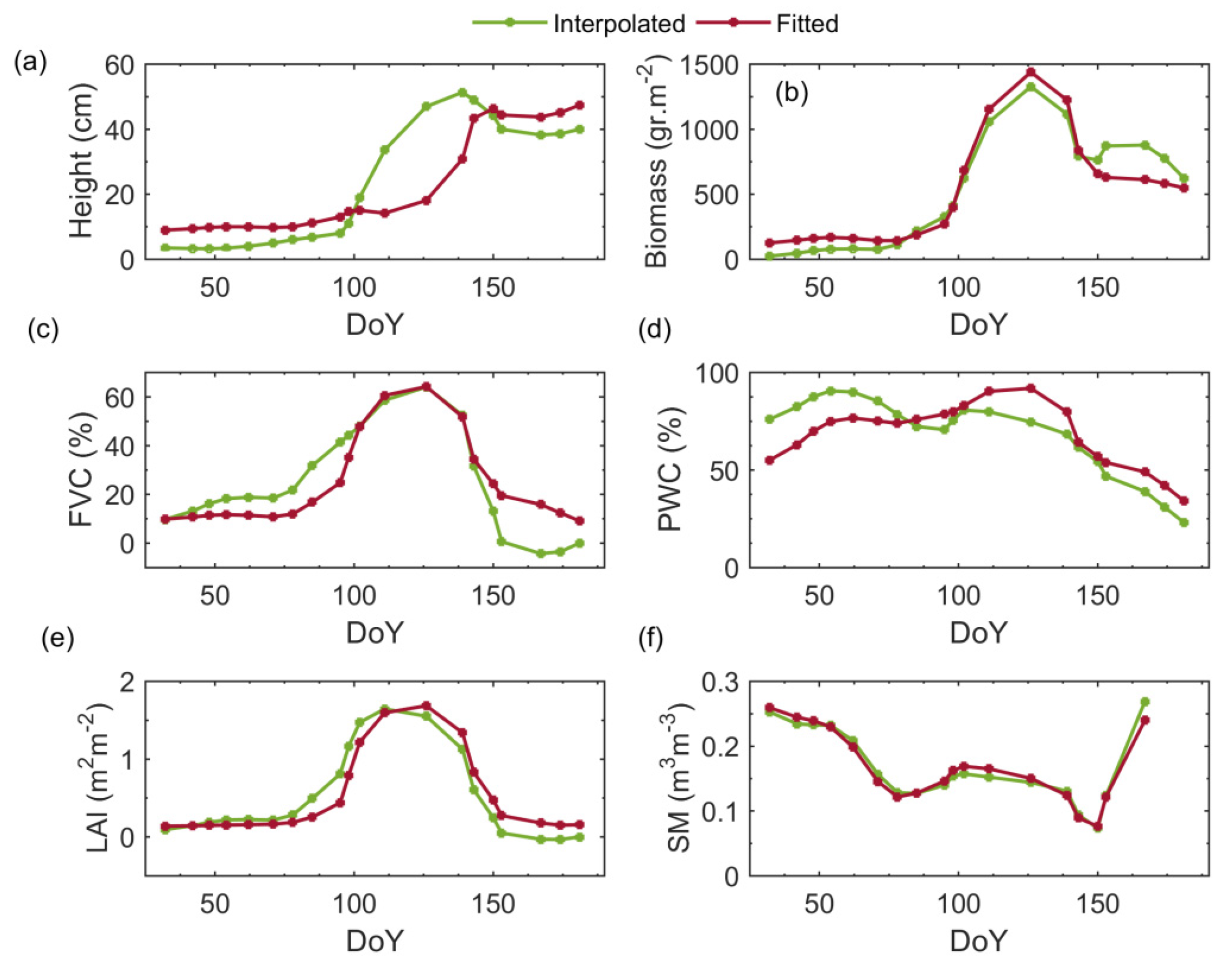
| Beam Mode | Acquisition Date (2015) | Day of Year (DoY) | Avg. Incidence Angle (°) | Slant-Range Pixel Spacing (m) | Azimuth Pixel Spacing (m) | Field Measurements (2015) |
|---|---|---|---|---|---|---|
| FQ16W | 16 February | 47 | 36 | 4.73 | 5.49 | 17 February |
| 12 March | 71 | |||||
| 5 April | 95 | 08 April | ||||
| 29 April | 119 | |||||
| 23 May | 143 | |||||
| 16 June | 167 | 16 June | ||||
| 10 July | 191 | |||||
| FQ11W | 23 February | 54 | 31 | 4.73 | 4.61 | 03 March |
| 19 March | 78 | 19 March | ||||
| 12 April | 102 | |||||
| 06 May | 126 | 06 May | ||||
| 30 May | 150 | 02 June | ||||
| 23 June | 174 | |||||
| 17 July | 198 | |||||
| FQ6W | 26 March | 85 | 25 | 4.73 | 4.70 | |
| 19 April | 109 | 21 April | ||||
| 13 May | 133 | 19 May | ||||
| 06 June | 157 | |||||
| 30 June | 181 | |||||
| 24 July | 205 |
| Polarimetric Parameters | Symbol/Acronym |
|---|---|
| Backscattering coefficient at HH, HV, and VV channels | HH, HV, VV |
| Ratio of backscattering coefficients at HH, HV, and VV channels | HH/VV, HV/VV |
| Normalized correlation between the copular channels (HH and VV) | γHHVV |
| Polarization phase difference between the copular channels (PPD) | PPD |
| Entropy and dominant alpha angle | H, α1 |
| Normalized between the 1st two channels in the Pauli basis (HH + VV and HH − VV) | γP1P2 |
| Field/laboratory Parameters | |
| Height | |
| Fraction of Vegetation Cover | FVC |
| Leaf Area Index | LAI |
| Fresh Biomass | |
| Percentage of Water Content | PWC |
| Soil Moisture | SM |
| Weather Records | |
| Precipitation | P |
| Evapotranspiration | ET0 |
| Temperature | TEMP |
| HH | VV | HV | HH/VV | HV/VV | γHHVV | PPD | H | α1 | γP1P2 | |
|---|---|---|---|---|---|---|---|---|---|---|
| F1 | −0.06 | 0.029 | 0.354 | −0.11 | 0.28 | −0.22 | −0.167 | 0.369 | 0.043 | −0.228 |
| F2 | 0.18 | −0.127 | −0.144 | 0.388 | −0.027 | −0.009 | −0.067 | −0.189 | 0.208 | 0.446 |
| F3 | 0.489 | 0.38 | 0.3054 | 0.046 | −0.029 | 0.061 | −0.059 | −0.073 | −0.015 | 0.072 |
| F4 | −0.01 | 0.021 | −0.074 | −0.089 | −0.081 | −0.016 | 1.006 | 0.038 | 0.032 | 0.063 |
| Independence | Levene’s Test | |
|---|---|---|
| Factor 1 | 0.05 | 0.428 |
| Factor 2 | 0.791 | 0.084 |
| Factor 3 | 0.09 | 0.067 |
| Factor 4 | 0.763 | 0.0586 |
| α | RSS | MSE | |
|---|---|---|---|
| Height | 0.89 | 224.31 | 10.31 |
| Biomass | 0.79 | 365,394.30 | 40,203.01 |
| FVC | 0.89 | 1047.06 | 85.32 |
| PWC | 0.70 | 102.63 | 7.54 |
| LAI | 0.70 | 0.75 | 0.45 |
| SM | 0.89 | 0.01 | 0.93 |
| Model ARIMAX | Equation | MAE | MSE | AIC | TIC | |
|---|---|---|---|---|---|---|
| Height | Ht = 5.72 + Ht−1 + 2.39 F1t + 6.12 F2t + εt | (5) | 1.97 | 11.32 | 5.21 | 0.06 |
| Biomass | Bt = 251.84 + Bt−1 + 164.59 F1t + 60.61 ET0 + 0.82 εt−1 + εt | (6) | 87.21 | 30,510.02 | 12.98 | 0.12 |
| FVC | FVCt = 31.95 + FVCt−1 + 15.57 F1t + 0.59 εt-1 + εt | (7) | 6.70 | 83.42 | 7.62 | 0.14 |
| PWC | PWCt = 63.44 + 0.94 PWCt−1 + 2.86 F1t + 0.23 TEMPt + εt | (8) | 3.55 | 8.72 | 6.88 | 0.03 |
| LAI | LAIt = 0.77 + LAIt−1 + 0.40 F1t + 0.68 εt−1 + εt | (9) | 0.20 | 0.91 | 0.54 | 0.16 |
| MSE-LSW | MSE-MS | |
|---|---|---|
| Height | 7.51 | 8.48 |
| Biomass | 21,708.02 | 36,664.60 |
| FVC | 62.95 | 75.92 |
| PWC | 5.4 | 22.1 |
| LAI | 0.04 | 0.07 |
| SM | 0.005 | 0.01 |
| Cointegration Equations | R2 | |
|---|---|---|
| Height(M9) | 6.92 + 1.01 Height(F11) | 0.6898 |
| Biomass(M9) | 116.55 + 1.12 Biomass(F11) | 0.9169 |
| FVC(M9) | 7.96 + 0.74 FVC(F11) | 0.7464 |
| PWC(M9) | −27.94 + 1.29 PWC(F11) | 0.6323 |
| LAI(M9) | 0.11 + 0.78 LAI(F11) | 0.8764 |
| SM(M9) | 0.09 + 1.22 SM(F11) | 0.9669 |
Publisher’s Note: MDPI stays neutral with regard to jurisdictional claims in published maps and institutional affiliations. |
© 2022 by the authors. Licensee MDPI, Basel, Switzerland. This article is an open access article distributed under the terms and conditions of the Creative Commons Attribution (CC BY) license (https://creativecommons.org/licenses/by/4.0/).
Share and Cite
Sipols, A.E.; Valcarce-Diñeiro, R.; Santos-Martín, M.T.; Sánchez, N.; de Blas, C.S. Time Series of Quad-Pol C-Band Synthetic Aperture Radar for the Forecasting of Crop Biophysical Variables of Barley Fields Using Statistical Techniques. Remote Sens. 2022, 14, 614. https://doi.org/10.3390/rs14030614
Sipols AE, Valcarce-Diñeiro R, Santos-Martín MT, Sánchez N, de Blas CS. Time Series of Quad-Pol C-Band Synthetic Aperture Radar for the Forecasting of Crop Biophysical Variables of Barley Fields Using Statistical Techniques. Remote Sensing. 2022; 14(3):614. https://doi.org/10.3390/rs14030614
Chicago/Turabian StyleSipols, Ana E., Rubén Valcarce-Diñeiro, Maria Teresa Santos-Martín, Nilda Sánchez, and Clara Simón de Blas. 2022. "Time Series of Quad-Pol C-Band Synthetic Aperture Radar for the Forecasting of Crop Biophysical Variables of Barley Fields Using Statistical Techniques" Remote Sensing 14, no. 3: 614. https://doi.org/10.3390/rs14030614





